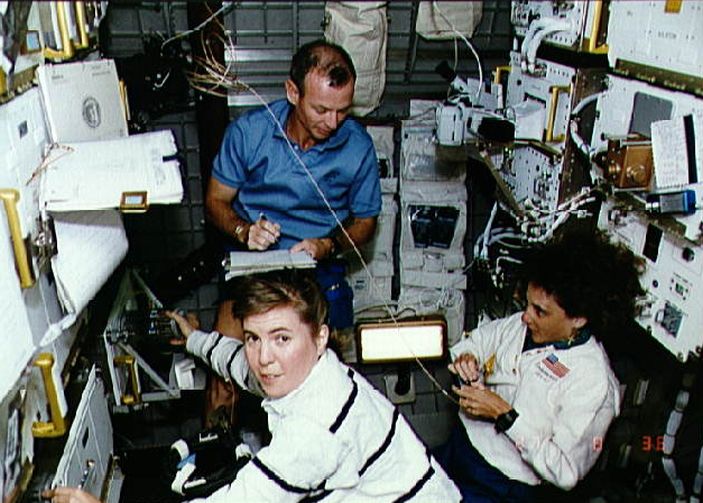
Fifty years ago this month, the first woman ventured into space. Thirty years ago, also this month, the first U.S. woman ventured into space. And twenty years ago this very week, two women from different backgrounds—one a U.S. Army aviator, the other a civilian engineer—flew together into space for the first time. STS-57 was not the first mission in history to include two female members. Nor was it the first mission to feature a military woman among its crew. However, with the presence of both civilian and military women aboard Endeavour when she rocketed into orbit on 21 June 1993, it offered a reminder of how far women astronauts had advanced in a mere handful of decades.
This relatively minor historic footnote was scarcely noticed at the time, for STS-57 was dominated by an all-new commercial scientific laboratory and the retrieval of a European free-flying satellite. The names of Janice Voss and Nancy Sherlock (today Currie) represented just two more female spacefarers, seemingly lost in a sea of astronauts and an ocean of shuttle missions. Yet both went on to carve remarkable careers at NASA. Voss went on to fly five times, including STS-83 and STS-94 in April and July 1997, which marked the only occasion in shuttle history on which the same crew launched twice to complete the same mission. Currie flew four times, including STS-88 in December 1998, the first International Space Station assembly mission. But it was STS-57 on which both women cut their teeth in low-Earth orbit.
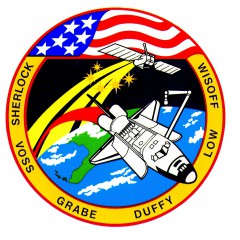
Like so many shuttle missions, preparations and processing began several years ahead of launch, but in the late spring of 1993 an unusual cargo was loaded aboard Endeavour for STS-57. Known as “Spacehab,” it was a small, flat-roofed laboratory and occupied barely a quarter of the shuttle’s payload bay. It was designed and built not by governments, but by private enterprise. Its truncated-cone configuration was immortalized by STS-57 Commander Ron Grabe in the shape of the mission’s official crew patch. When Spacehab-1 rose from Earth in June 1993, it marked the culmination and realization of a decade-old dream for aerospace engineer Bob Citron, who founded Spacehab, Inc. in 1983 and incorporated it the following year. Since 2009, the company has been known under its present corporate name, Astrotech Corp.
“People often ask me why I started Spacehab,” Citron recalled on Astrotech’s website, “and my response usually goes something like this: It took a small group of wide-eyed dreamers and determined space enthusiasts who believed we could pull it off. We didn’t have a clue about the enormous problems we would encounter and the nearly insurmountable technical, financial, and institutional roadblocks that would stand in our way. Nobody had done anything like this before.” The primary goal of Citron—who died from prostate cancer in January 2012—was to create the world’s first privately funded company to support human space missions, using the cavernous payload bay of the shuttle as a carrier of commercial pressurized research modules.
The need for such provision was self-evident. In the shuttle’s pre-Challenger heyday, more than a dozen missions were planned each year and a primary thrust of the Reagan Administration’s 1983 space policy was for the commercial exploitation of the microgravity environment. Already, middeck lockers were being used to carry out experiments in crystal growth and pharmaceutical development, but the limited volume meant that their commercial viability was restricted. The Spacehab module—accessed by a tunnel connected to the middeck airlock hatch—measured 9 feet long, 11 feet high, and 13.5 feet across the width of the payload bay and effectively quadrupled the shuttle’s available pressurized working and living envelope. It supplied environmental, electrical, temperature, command, and data provisions and could house a maximum of 61 middeck-sized lockers and up to two large racks, either in “single” or “double” configurations.
After incorporating Spacehab in 1984, Citron admitted that the company was “on the verge of failure on a number of occasions during its first years,” until he brought in critical professional management personnel and “things started to happen” through negotiations with NASA, the Italian Alenia Spazio, and German MBB-Erno organizations and Martin Marietta and McDonnell Douglas. By the end of 1985, only weeks before the Challenger tragedy, Spacehab was tentatively scheduled for its first flight in 1987 and a lease of $5 million per mission was quoted by Flight International. Early plans called for the assembly of three modules, but center-of-gravity issues gave NASA cause for concern and threatened to affect the placement of other cargoes in the payload bay.
Ultimately, McDonnell Douglas was selected as the lead contractor and a decision was made to build two flight modules and an engineering test model. Other worries lingered, but in late 1986 Spacehab signed a Space System Development Agreement, in which NASA agreed to fly five inaugural missions. By October 1987, 42 firm requests had been received, with lockers priced at $300,000 for non-government users and $100,000 for government agencies and contractors. The concept was now growing from initial designs into reality. In September 1989, Patent No. 4,867,395 for a “Flat End-Cap Module for Space Transportation System” was awarded to Spacehab, Inc. by the U.S. Patent Office.
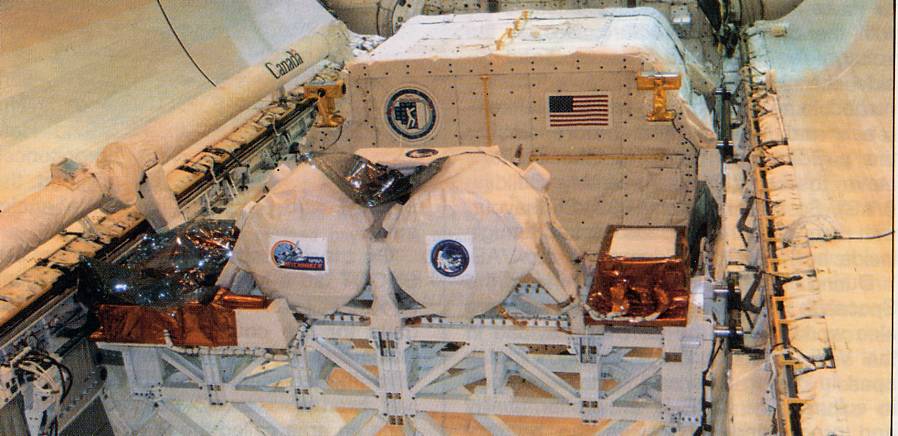
Hopes to fly the modules on very early post-Challenger missions received a rude awakening, however, and it was expected to be at least three years after the resumption of shuttle operations before the maiden Spacehab flight could be expected. According to NASA’s April 1988 schedule, Spacehab-1 was listed as a primary payload on STS-51 in June 1991, co-manifested with the retrieval of the European Retrievable Carrier (EURECA) and the deployment of Italy’s LAGEOS-II satellite. This schedule slipped and, at length, the first module was not unveiled until early 1992 at the custom-built Spacehab Payload Processing Facility (SPPF) at the Kennedy Space Center, Fla. By this time, under the Commercial Middeck Augmentation Module procurement, initiated in February 1990 and formally signed the following December, NASA agreed to lease 200 Spacehab lockers at a cost of $184.2 million. Over the coming years, the SPPF would host more than a hundred astronauts and cosmonauts, enabling them to train on real experiment hardware.
The formal unveiling of Spacehab coincided closely with the assignment of the first crew members for STS-57. The names of Payload Commander David Low and Mission Specialist Janice Voss were announced in February 1992. (It is a tragic coincidence that, like Bob Citron, both astronauts later succumbed to cancer—Low of colon cancer in March 2008 and Voss of breast cancer in February 2012.) Within weeks of their announcement to STS-57, four more astronauts were named to the crew: Commander Ron Grabe, Pilot Brian Duffy, and two further Mission Specialists, Nancy Sherlock and Jeff Wisoff. For Duffy, who was in quarantine at KSC, a few days ahead of his STS-45 mission at the time, it came as a special surprise. “Jeez, I sure hope I like this,” he remembered asking himself, “because I just signed up for two of them!” In all seriousness, Duffy appreciated the fact that he would be entering STS-57 training pumped up, fresh, and ready to go. At the time, launch was provisionally scheduled for late in April 1993.
Janice Elaine Voss came from South Bend, Ind., where she was born on 8 October 1956. Space exploration as a possibility first entered her head whilst in the sixth grade, when she read Madeleine L’Engle’s novel A Wrinkle in Time; this guided her deeper into science fiction and from thence into science generally. “I just found the whole thing so fascinating,” she told the NASA oral historian before her last shuttle mission, “that I’ve never been interested in doing anything else.” Her love of learning was such that, in 1998, with four shuttle missions and a handful of degrees to her credit, she once told a group of pre-teen girls that her next personal goal was to learn the piano.
In high school, she pursued mathematics and science. Later, she earned a degree in engineering from Purdue, whilst working on a NASA co-operative program in computer simulations with the Engineering and Development Directorate at the Johnson Space Center in Houston, Texas. Reflecting on Purdue, Voss was well aware of the fact that the exalted college had produced more astronauts than any other U.S. educational institution, outside of the military academies. After gaining her degree in 1975, she completed a master’s qualification in electrical engineering and returned to JSC in 1977 as a crew trainer, teaching re-entry guidance and navigation. Ten years later, she gained her doctorate in aeronautics and astronautics from MIT and worked for a time for Orbital Sciences Corp. Finally, on her fifth application to NASA, she was accepted as an astronaut candidate in January 1990.
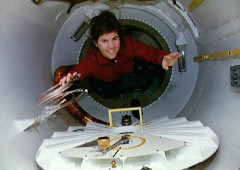
Also selected that year was U.S. Army aviator Nancy Jane Sherlock. Her path to NASA could not have been more different from that of Voss. Born on 29 December 1958 in Wilmington, Del., she admitted that a career in the space program—or even in the uniformed military services—was unthinkable during her childhood. “Women weren’t military pilots,” she told the NASA oral historian. “Women weren’t astronauts. It really wasn’t a concrete goal of mine until much later in my life.” Having said this, she considered it a surprisingly natural progression to enter the military and pursue an education which ultimately opened professional routes which might previously have been closed to her. Only at the end of her time in high school did the military begin to accept female aviators, and only whilst she was at Ohio State University, studying the biological sciences, did NASA begin to accept female astronauts. Upon receipt of her degree in 1980, she entered the Army with a dream of becoming an aviator and perhaps eventually a military doctor. However, women were gradually being introduced into combat positions and after rotary-wing pilot training she served as an instructor pilot at the Army Aviation Center. Other positions followed—section leader, platoon leader, and brigade flight-standardisation officer—and in 1985 Sherlock earned a master’s degree in safety engineering from the University of Southern California.
Eventually, she became a Master Army Aviator and by the end of her military career in 2005 she had logged over 3,900 hours in the air aboard various rotary-wing and fixed-wing aircraft. Years later, she remembered her first day in a helicopter and had the instant thought: This is for me. This is what I want to do. Her decision to pursue a master’s in safety engineering is an interesting side note. “When I was in flight school,” she explained, “we actually had an accident that killed my instructor pilots and two of the guys that I flew with every day. It was just kind of a strange coincidence that I wasn’t in the aircraft. It was at that time that I decided to devote a portion of my career and my academic life to safety engineering.” Later, during her NASA life, she went on to earn a doctorate in industrial engineering, with emphasis upon human factors. “Catastrophic things can happen,” she reflected, sadly, “due to human error in the cockpit or human error combined with a malfunction in the aircraft.”
Sherlock’s arrival at JSC came in September 1987 as a flight simulation engineer on the Shuttle Training Aircraft. She had earlier applied unsuccessfully for admission into that year’s astronaut candidate class. That same year her daughter Stephanie was born. Three years later she was selected as an astronaut and for the first half of the 1990s until she met her future husband, Davie Currie, she was a single parent. “It was somewhat difficult for a mom to have a lifestyle like that,” she said of her early NASA career, “gone an awful lot on travel and studying a lot at home.” That study was particularly intense in the months leading up to STS-57, for Sherlock served as the flight engineer, responsible for assisting Commander Grabe and Pilot Duffy with monitoring Endeavour’s systems during ascent and re-entry. By the end of her career, she had served as flight engineer on four shuttle missions, more times than any other female astronaut.
All six members of the crew were responsible for aspects of Spacehab-1, which encompassed a wide range of experiments in the life and microgravity sciences. A dozen of these were sponsored by NASA Centers for the Commercial Development of Space and one by the agency’s Langley Research Center of Hampton, Va., and many had flown aboard previous missions. The year 1993 was expected to mark a significant watershed for commercial access to space, with a total of 56 research payloads planned aboard Spacehab-1 and, in November, aboard Spacehab-2.
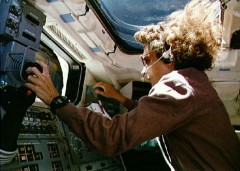
Aboard STS-57, materials science investigations included the Equipment for Controlled Liquid Phase Sintering Experiments (ECLiPSE), developed by the University of Alabama at Huntsville, Ala., which sought to explore “sintering”—a process by which metallic powders are consolidated into metals at temperatures of only 50-75 percent of that needed to melt all the constituent phases—of several metallic composites, with possible applications ranging from stronger, lighter, and more durable materials for bearings, cutting tools, electrical brushes, and contacts. Other areas of research included demonstrations of the feasibility of producing materials for high-speed digital circuits, as well as “zeolites,” commonly used in catalysts, molecular sieves, absorbents, and ion-exchange methods, and experiments in gas-permeable polymers and the processing of advanced polymer membranes in support of the commercial membrane industry.
In the life sciences, Astroculture continued a programme of testing the equipment for an operational plant-growth unit. BioServe Space Technologies, based at the University of Colorado in Boulder, provided a pilot laboratory to support various experiments, including the Rhizobium trifolii bacterium, which is known to form symbiotic relationships with Earth-plants, such as alfalfa, clover, and soybean. Such research was expected to lead ultimately to new insights about manipulating the processes responsible for crop infections. Other experimental foci included observations of the growth and development of the E. coli bacterium and studies of gravitational influences upon frogs’ kidney cells. BioServe’s Commercial Generic Bioprocessing Apparatus supported experiments into biomedical testing and drug development and controlled ecological life-support systems, agricultural development, and manufacture of biological-based materials. These placed emphasis upon the processes by which cells destroy foreign materials and examined the ability of the immune system to respond to infections. Long-term implications for the work included an improved understanding of bone and developmental disorders and the healing of wounds and cancers and other cellular diseases. The development of wasps, seeds, algae, and micro-organisms in the weightless environment was also monitored.
The Organic Separation payload offered the commercial and scientific communities an opportunity to separate cells and particles for analysis, whilst next-generation protein crystal growth equipment employed vapour-diffusion and direct-control methods. Twelve adult male rats were also flown in a pair of Animal Enclosure Modules and were used to evaluate the performance of implanted growth factors. NASA provided a facility to accommodate cell and tissue cultures, a charged particle directional spectrometer, a three-dimensional accelerometer, the Space Acceleration Measurement System, and an experimental life-support apparatus to test water-recycling methods for Space Station Freedom.
A series of Human Factors Assessment studies, mainly performed by orbiter crew members Grabe, Duffy, and Sherlock, involved the collection of data on the astronauts’ ease of movement through the middeck-to-Spacehab tunnel, the shuttle’s acoustic and lighting environment, and the usefulness of electronic procedures to fulfil tasks. Endeavour’s pilots also participated in neutral body posture investigations, sponsored by JSC’s Space and Life Sciences Directorate, to observe changes in spinal lengthening and overall posture in the microgravity environment.
By the time the long-delayed STS-55 mission returned to Earth in early May 1993, the Spacehab-1 flight had slipped into early June. However, engineers discovered that one of two springs which keep ball bearings in place in the high-pressure oxygen turbopump of the No. 2 main engine had an improperly-placed inspection stamp, which it was thought might weaken it to the point of breakage. It was considered prudent to replace the turbopump and a firm launch date of the 20th—Brian Duffy’s 40th birthday—was established. Grabe had hoped to send his crewmate over the hill in style with an on-time launch, but it was not to be. The countdown proceeded normally until the standard “hold” at T-9 minutes, when weather conditions at all three Transoceanic Abort Landing sites of Banjul in Gambia, Ben Guerir in Morocco, and Moron in Spain, and the Shuttle Landing Facility itself at the Cape, were considered unacceptable to support Endeavour’s flight. Nonetheless, a decision was taken to proceed down to T-5 minutes and wait out the weather, but to no avail. Eventually, the 71-minute launch window ran out and the attempt was scrubbed.
Brian Duffy would have to wait another day for launch, but the wait would be worth it.
The second part of this article will appear tomorrow.
Want to keep up-to-date with all things space? Be sure to “Like” AmericaSpace on Facebook and follow us on Twitter:@AmericaSpace



